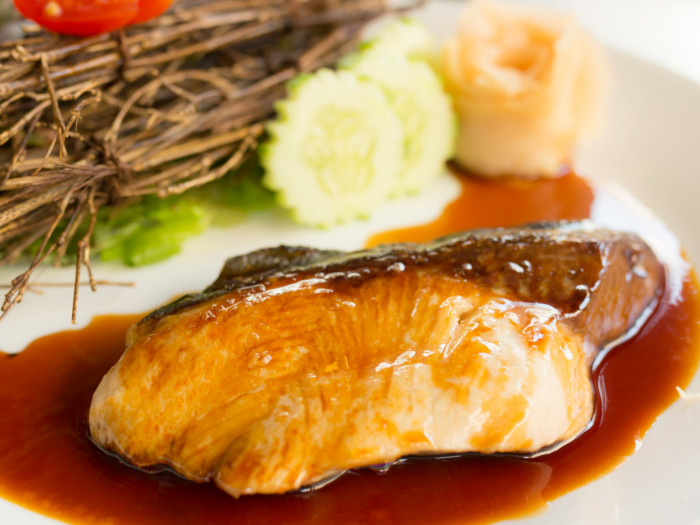Sablefish is a delicious and popular marine food source with a number of surprising health benefits.
What is Sablefish?
Sablefish or black cod (Anoplopoma fimbria), is also known as Pacific cod, wild Alaskan cod, and gindara. It is also sometimes colloquially called ‘butterfish’ as a nod to its rich, buttery taste and oily texture. Sablefish is a sustainable alternative to more commonly used fish. Perhaps the most confusing of alternative names is ‘black cod’, as it is not a member of the cod family and has a different habitat, flavor, and texture. [1]
Sablefish Nutrition
This fish contains more omega-3 than salmon or tuna and is rich in vitamin B12. It’s an excellent source of protein and minerals such as iron and calcium. [2]

Sablefish is commonly known as black cod. Photo Credit: Shutterstock
Serving Size : Nutrient Value Water [g] 62.85 Energy 250 Energy [kJ] 1046 Protein [g] 17.19 Total lipid (fat) [g] 19.62 Ash [g] 1.35 Calcium, Ca [mg] 45 Iron, Fe [mg] 1.64 Magnesium, Mg [mg] 71 Phosphorus, P [mg] 215 Potassium, K [mg] 459 Sodium, Na [mg] 72 Zinc, Zn [mg] 0.41 Copper, Cu [mg] 0.03 Manganese, Mn [mg] 0.02 Selenium, Se [µg] 46.8 Thiamin [mg] 0.12 Riboflavin [mg] 0.12 Niacin [mg] 5.13 Pantothenic acid [mg] 0.87 Vitamin B-6 [mg] 0.35 Folate, total [µg] 17 Folate, food [µg] 17 Folate, DFE [µg] 17 Vitamin B-12 [µg] 1.44 Vitamin A, RAE [µg] 102 Retinol [µg] 102 Vitamin A, IU [IU] 338 Fatty acids, total saturated [g] 4.1 12:0 [g] 0.01 14:0 [g] 0.92 16:0 [g] 2.63 18:0 [g] 0.52 Fatty acids, total monounsaturated [g] 10.33 16:1 [g] 1.57 18:1 [g] 5.22 20:1 [g] 1.82 22:1 [g] 1.67 Fatty acids, total polyunsaturated [g] 2.62 18:2 [g] 0.21 18:3 [g] 0.12 18:4 [g] 0.15 20:4 [g] 0.13 20:5 n-3 (EPA) [g] 0.87 22:5 n-3 (DPA) [g] 0.22 22:6 n-3 (DHA) [g] 0.92 Cholesterol [mg] 63 Tryptophan [g] 0.19 Threonine [g] 0.75 Isoleucine [g] 0.79 Leucine [g] 1.4 Lysine [g] 1.58 Methionine [g] 0.51 Cystine [g] 0.18 Phenylalanine [g] 0.67 Tyrosine [g] 0.58 Valine [g] 0.89 Arginine [g] 1.03 Histidine [g] 0.51 Alanine [g] 1.04 Aspartic acid [g] 1.76 Glutamic acid [g] 2.57 Glycine [g] 0.83 Proline [g] 0.61 Serine [g] 0.7 Sources include : USDA [3]
Health Benefits
Sablefish with high levels of omega-3 fatty acids, EPA and DHA, has the following benefits:
- Improving eye health
- Promoting bone health
- Lowering blood pressure
- Regulating cholesterol levels
- Boosting metabolism
- Alleviating stress [4]
- Boosting immune system
- Promoting better digestion
- Reducing cramps
- Aiding in weight loss
Note: Thanks to the low levels of mercury, cooked black cod can be a good option for pregnant or nursing women.
Cod vs Sablefish
- Species: Cod and black cod (or sablefish) are two different species of fish
- Source: Cod can be found in the Atlantic Ocean, whereas black cod inhabits the Pacific Ocean
- Taste: Black cod has higher fat content than cod and is more savory [5]
Substitutes
Although the unique flavor and texture of black cod make it an optimal choice for some recipes, it is not the easiest fish to find. In our daily diets, it can be substituted with more commonly found fish with similar properties. The most popular alternatives include:
- Chilean Sea Bass: It is the best substitute for sablefish due to a similar buttery taste and richness of flesh. It can be grilled or broiled
- Escolar: It is sometimes confused with sablefish due to its similar texture. Escolar can be delicious, but make sure you do not eat more than 6oz at any one time [6]
- Salmon: This fish with its unique flavor and high-fat content can be used as a substitute in Japanese recipes
- Halibut: It is leaner and firmer than sablefish and it becomes flakier and more succulent with cooking.
- Arctic Char: This fish is sweet and tender and can be enjoyed as smoked fish
Word of Warning: This fish is not suitable for people with fish allergies or those with irritable bowel syndrome. Smoked sablefish should not be eaten by people taking MAO inhibitor antidepressants.
